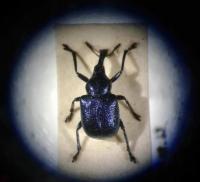The value of museum collections
Museum collections are an invaluable tool for taxonomists and biological recorders. As well as being invaluable, they are often under-valued and under-used. We should cherish and value our museum collections - and their curators - especially when so many of them are under increasing pressure.
Since joining the biological recording community through my role on the Tomorrow's Biodiversity project, I've made use of collections several times. My first experience of a proper museum collection was a visit to World Museum Liverpool early in 2015, along with many of Shropshire's entomologists, on what now seems to have become an annual pilgrimage. The rest of the group had made their requests in advance, and Tony the curator had kindly got out the requested taxa to be used as reference specimens. I was fascinated to watch my colleagues use these reference collections to compare with their own tricky specimens, and help them arrive at an identification.
 At that point I hadn't really worked out what species groups I wanted to focus on personally - and rather naively suggested weevils may be an under-recorded group crying out for someone to 'do' them. Several hours later, after being presented with countless trays of pinned weevil specimens, and despite marvelling at their diversity and beauty, I decided that maybe this was not the best group for a fledgling entomologist to start with! Without seeing the weevil collection for myself and realising just how many species there are, the variability that can be present within a species, and just how similar to each other a lot of species look, I might have jumped in very much at the deep end and quickly got bogged down and disheartened. So, in this case, the collection served as a (much needed!) warning!
At that point I hadn't really worked out what species groups I wanted to focus on personally - and rather naively suggested weevils may be an under-recorded group crying out for someone to 'do' them. Several hours later, after being presented with countless trays of pinned weevil specimens, and despite marvelling at their diversity and beauty, I decided that maybe this was not the best group for a fledgling entomologist to start with! Without seeing the weevil collection for myself and realising just how many species there are, the variability that can be present within a species, and just how similar to each other a lot of species look, I might have jumped in very much at the deep end and quickly got bogged down and disheartened. So, in this case, the collection served as a (much needed!) warning!
 On our latest visit I made a much more positive use of World Museum Liverpool's collections, this time focussing on harvestmen. I examined many of their specimens and made notes and sketches which will help me in the future - this is a group I'd like to start looking at in more detail. I find that features on a living specimen are much easier to see once I've spent time studying them on a preserved specimen.
On our latest visit I made a much more positive use of World Museum Liverpool's collections, this time focussing on harvestmen. I examined many of their specimens and made notes and sketches which will help me in the future - this is a group I'd like to start looking at in more detail. I find that features on a living specimen are much easier to see once I've spent time studying them on a preserved specimen.
Since then I've seen collections used as education and engagement tools at various entomological events, including this year's EntoSci day at Harper Adams University. It's hard to resist being drawn to a stall displaying a tray of brightly coloured butterflies or bumblebees, or squealing at the enormous size of some of the planet's largest invertebrates. There's nothing quite like actually being able to see specimens of these creatures - looking at photographs doesn't quite compare.
 Unfortunately not everyone has the time, money or means to visit collections themselves. There may also be issues with workspace at the museum, or the capacity of curators to spend time with visitors wishing to use the collections, however much they might want to help. But, if people can't go to the collections, the collections must come to the people! This was demonstrated to great effect on our recent Pseudoscorpion Workshop, held at Preston Montford.
Unfortunately not everyone has the time, money or means to visit collections themselves. There may also be issues with workspace at the museum, or the capacity of curators to spend time with visitors wishing to use the collections, however much they might want to help. But, if people can't go to the collections, the collections must come to the people! This was demonstrated to great effect on our recent Pseudoscorpion Workshop, held at Preston Montford.
 The aim of this workshop was two-fold: firstly to introduce people to pseudoscorpion identification, and secondly to test a new FSC key to the group which is currently being developed by our publications unit. However, the two main stumbling blocks were the fact the pseudoscorpions are quite hard to find in any great number, and the informal 'workshop' style of the event meant that we were lacking a national expert to confirm our ID and confidently show us specimens of certain species.
The aim of this workshop was two-fold: firstly to introduce people to pseudoscorpion identification, and secondly to test a new FSC key to the group which is currently being developed by our publications unit. However, the two main stumbling blocks were the fact the pseudoscorpions are quite hard to find in any great number, and the informal 'workshop' style of the event meant that we were lacking a national expert to confirm our ID and confidently show us specimens of certain species.
 The answer? We borrowed the entire pseudoscorpion collection from World Museum Liverpool, kindly entrusted to us for the weekend. What a responsibility! This collection proved absolutely invaluable for our workshop. Participants took specimens, either with or without reading the species label first, and ran them through the key, comparing the species name they arrived at with the correct identification label in the specimen tube. This not only helped with people's individual learning, but was also a great way to test out how the key worked. Our comments and suggestions will be fed back to FSC Publications.
The answer? We borrowed the entire pseudoscorpion collection from World Museum Liverpool, kindly entrusted to us for the weekend. What a responsibility! This collection proved absolutely invaluable for our workshop. Participants took specimens, either with or without reading the species label first, and ran them through the key, comparing the species name they arrived at with the correct identification label in the specimen tube. This not only helped with people's individual learning, but was also a great way to test out how the key worked. Our comments and suggestions will be fed back to FSC Publications.
So the uses of museum natural history collections are many and varied - I've touched on only a few I've had personal experience of. As I've mentioned, they are reference collections for biological recorders, teaching and education resources, and public engagement tools. They can be visited, or they can travel to you! They can also be used by taxonomists to correctly classify new species or split existing species groups, they can be a source of genetic material for sequencing or comparitive studies, and they can provide physiological measurements for analysis in relation to various factors.
And, maybe most importantly of all, they can make you go 'wow'.
- Anonymous's blog
- Log in or register to post comments




